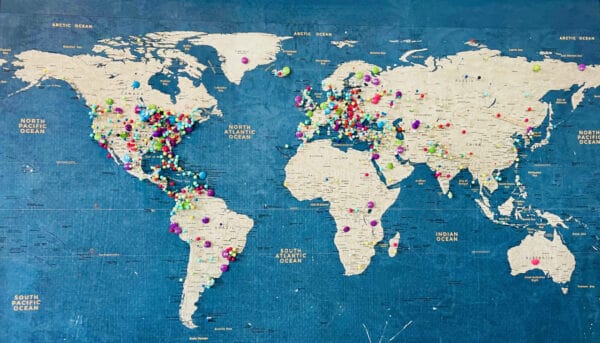In the face of a highly fragmented financial services landscape and varying levels of maturity across its markets, Claire Huddleston, Sales and Marketing Director at Clear Junction, explains how digitization and remittances can drive Africa’s continuing economic development.
Huddleston also talks about the key economic challenges facing different nations and how they aim to address them.
Remittances are a growing source of income for families worldwide. They’re also becoming more streamlined as a wide range of Fintechs compete to provide more affordable cross-border transactions. Consumers and business organizations now have numerous viable options that can help them carry out frictionless international payments.
Our conversation with Claire is shared below.
Crowdfund Insider: What are the biggest economic challenges facing countries across Africa, and what role can remittances play in addressing them?
Claire Huddleston: Across the continent, banking penetration rates are still below 50%, so a key challenge and focus for banks, governments and tech solution providers is driving greater financial inclusion through a range of channels.
Remittances are one of the most important elements driving financial inclusion – not just for empowering individuals and families with the finances to enhance their lives, but also for the economic empowerment for the entire African continent.
According to data from the United Nations, Africa received $100 billion in remittance values in 2022 alone, almost 6% of the continent’s GDP. More than 200 million people across Africa benefit from receiving remittances, and in the last decade, remittance inflows have doubled.
Improving remittance flows improves the lives of recipients both directly and indirectly; directly through increased household purchasing power and accessing formal financial services; indirectly through increased revenues for remittance service providers and the businesses people buy from. It ultimately means more tax revenues to fund infrastructure development projects, business creation and employment opportunities.
All this adds up to greater financial inclusion.
But financial inclusion doesn’t just apply to underserved or unbanked individuals; businesses can also find themselves excluded from formal financial services. The size of the cash-heavy unbanked B2B segment across Africa is estimated to be eight times larger than the digitally-enabled online B2B segment. It’s a substantial gap that can be bridged with technology, and remittances have the potential to help unbanked SMEs and small traders access the formal financial services they need to succeed.
Crowdfund Insider: Which African countries are leading the charge when it comes to electronic payments?
Claire Huddleston: As a whole, Africa had a mobile money transaction value of $495 billion in 2020. That’s almost two-thirds of the global value of $767 billion, according to the GSMA, underlining that the region’s banking future is secured by monetary digitisation.
But leading the way is Nigeria, the most heavily populated country with the largest economy. Since the introduction of the Central Bank’s 2012 cashless policy, electronic payments have skyrocketed. In 2016, Nigerians completed 154.5 million digital payments, representing an annual average of 12.9 million transactions per month. By the end of 2022, average monthly transfers stacked up to 427.8 million as payments volume topped 5.1 billion.
The positive ripple effects of digitisation are fully evident across Nigeria, which has also led the unicorn counts in Africa with five of the seven known unicorns originating in the country. These include Interswitch, Jumia, Flutterwave, Opay, and Andela.
Furthermore, the Central Bank leapt ahead in the global CBDC race with the 2022 launch of its digital currency eNaira, and it was recently announced that the Central Bank of Nigeria (CBN) has greenlit a pilot launch of the cNGN stablecoin, a digital currency backed by a consortium of Nigerian banks and fintechs which aims boost the nation’s economy.
It’s worth noting that Nigeria is among the top 10 remittance recipients globally, with $19.3 billion in 2022.
Crowdfund Insider: What barriers are preventing remittance realising its potential in Africa?
Claire Huddleston: Currently, the high cost of transfers is a major challenge preventing the full potential of remittances to drive economic benefits. The average cost of sending $200 to Africa was 8.5% of the amount transferred compared to less than 6% globally in 2022. It’s not just international remittances affected by high costs. Around one-fifth of remittances are generated within the African continent itself, but they face the same challenges afflicting the efficiency of pan-regional remittances.
Varying transfer costs between neighbouring country corridors – as high as 14% in some cases – can also block or eat into money available to individuals and families.
The international community’s commitment to reducing the cost of remittances to less than 3% by 2030 as part of the Sustainable Development Goals also remains unfulfilled, including the objective of reducing the transfer cost in certain corridors to below 5% by 2030.
Several factors contribute to this situation, including the lack of competition in these corridors, scarce information on the different cost service options, limited number of migrants in the sender’s country of residence, instability of the exchange rate in the recipient country, low level of financial development, and the utilisation of high-cost transfer instruments, such as cash and bank transfers.
According to the UN, if transaction costs of migrant remittances was reduced to below 3%, and remittance corridors with costs higher than 5% were eliminated, Africa could see the volume of remittance flows received from its migrants double by 2030.
It’s, therefore, essential for remittances to be as fast and cost-effective as possible. With mobile phones accounting for about 75% of all online traffic in Africa, it’s no surprise banks and fintechs across the region cite mobile wallet apps and digital payment systems as their most critical product development focus for the next few years.
The mobile money and remittance spaces are primed for a wave of innovation as telcos that have traditionally dominated these spaces face more competition from fintechs and remittance companies with faster and lower-cost services.
Mobile money has the power to transform how remittance services are provided in Africa, offering an effective platform to reduce remittance transfer costs. Thanks to its accessibility, mobile money promotes financial inclusion, providing underserved communities access to formal financial services.
Crowdfund Insider: How can remittances be made faster and more secure without compromising compliance?
Claire Huddleston: It’s clear that remittance companies in Africa need access to services with the best FX rates on the most commonly used currencies like EUR or GBP so their customers benefit from the best value. On the other side of those institutions are families who depend on those services.
Employing secure and proven technology is of paramount importance, as is the knowledge that when funds are sent, they will appear in the recipient’s account in as little as a few minutes. Recipients can’t afford delays in receiving funds. Its vital fund flows are fast, secure and compliant with all regulatory obligations.
It’s imperative that African remittance companies and fintechs seek partners with solutions capable of overcoming the challenges associated with sending cross-border payments, and with exceptional regulatory expertise.
Such partnerships are crucial for mobilising technological innovations and driving financial inclusion on an individual and wider level. Reduced transaction costs and faster, more secure remittance flows mean increased prosperity for all.



